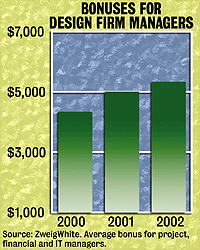For several years, design professionals sat in the catbird seat, able to parlay personnel shortages in a boom market into significant pay and benefit packages. Design firms lamented dealing with the "domino effect," where they would lose a top person to another firm and then be forced to steal a top performer from a third firm, and so on. How times have changed. Most classes of managers have seen a flattening out of their salaries and compensation as many markets have fallen off and demand for new personnel has dwindled.
 |
One of the most dramatic pieces of evidence that there has been a sea-change in management pay patterns is that salaries for project managers have been on ice for the past three years, according to a survey of design and environmental firm management compensation by ZweigWhite, a Natick, Mass.-based industry management consultant. The median salary for PM's in 2002 was $75,000, unchanged from 2001 and up only $1,000 from 2000.
"Project managers have been the biggest victims of the current salary compression," says Mark Zweig, CEO. He notes that project managers are among the highest-ranking and highest-paid people in design firms whose job is measured in billable hours on specific projects. With a market downturn, firms are scrambling to sustain those billable hours and are rethinking how much they should pay their PMs, he says.
 |
There may be another, more subtle recession-related reason for this salary stagnation. "During recessionary times, older employees are more likely to opt for early retirement," says Jeffrey M. Robinson, president of PAS Inc., a Saline, Mich.-based management consulting firm. "These people are usually at the high end of the salary scale and [their retirement] can affect the mix of survey respondents," he says.
Satellite office managers also are under compensation pressure. "Satellite office manager is a power position in firms that are organized along geographic lines," says Zweig. But he says that design firms increasingly are reorganizing around market alignment and geography is playing a smaller role. Where it is the market rather than the location that is the profit center, the satellite office manager's role takes on more of an administrative function, Zweig says.
The ZweigWhite survey shows that industry demand remains strong for a few skills. Information technology managers and business development managers continue to be sought after. "IT continues to be hot as technology advances," says Zweig. "Design firm technology isn't just limited to [computer-aided design] programs anymore." Client demand for project Websites and network connections are forcing design firms to recruit and retain top IT people, Zweig says.
Overall, salary increases will be less than in the past few years, but the outlook is not grim. "We are seeing firms budget 3.5 to 4.0% for straight raises and 4.5 to 5.0% to take into account pro-motions," says Bill Fanning, research director for PSMJ, a Newton, Mass.-based management consulting firm. Robinson agrees. "We see increases of around 4% next year, but there are some firms that aren't planning to give raises," he warns.
Bonuses are on the chopping block. "Bonuses look somewhat down from past years," says Fanning. He notes that they also are falling out of favor as a management tool as firms seem to be devoting a greater percentage of discretionary profits to retirement accounts rather than straight cash bonuses. "We used to see about 10% of the discretionary profits put into retirement accounts, but now it's not unusual to see it at 30%," he says. "It could be that more principals are nearing retirement age and are deciding that Social Security isn't enough."
But one significant change in bonus patterns among design firms is the return of firm-wide profit distribution based on the number of shares owned. In recent years, many design firms tinkered with bonus programs that attempted to reward specific individuals or groups within firms. But now, many firms are targeting more of the profits toward shareholders "to keep up the value of the firm's stock," Zweig says. He notes that when you target top performers for large bonuses in good years, these same top people take the greatest hit in compensation in lean years, causing morale problems. "There are other, better ways to reward top performers, such as bigger salary increases," Zweig says.
Click here for SUMMARY:Strong Volume, Weak Prices >>
Click here for FORECAST: Soft Markets Sap Inflation >>
Click here for WALLBOARD: Europe Fines Big Producers >>
Click here for INTERNATIONAL: Inflation Rolled Back Again >>
